Tennen kokekkô / A Gentle Breeze in the Village (Nobuhiro Yamashita, 2007)
Seen in early January 2008
 The Japanese title of Yamashita's new films seems to translate to "natural cockle-doodle-doo". Although about the first thing one hears in the film is a rooster crowing (and we do see chickens from time to time), the significance of the title is not especially clear to me.
The Japanese title of Yamashita's new films seems to translate to "natural cockle-doodle-doo". Although about the first thing one hears in the film is a rooster crowing (and we do see chickens from time to time), the significance of the title is not especially clear to me. 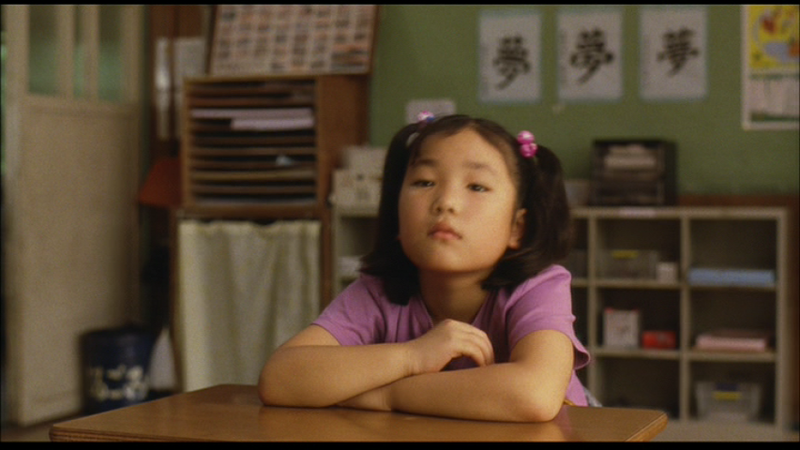 The film (based on a popular shoujo manga) is set in Shimane Prefecture (the second least populous prefecture of Japan). Clearly built in the post-war baby boom era, the combined grade school and middle school now has less than 10 students -- and is probably reaching the end of its days.
The film (based on a popular shoujo manga) is set in Shimane Prefecture (the second least populous prefecture of Japan). Clearly built in the post-war baby boom era, the combined grade school and middle school now has less than 10 students -- and is probably reaching the end of its days. 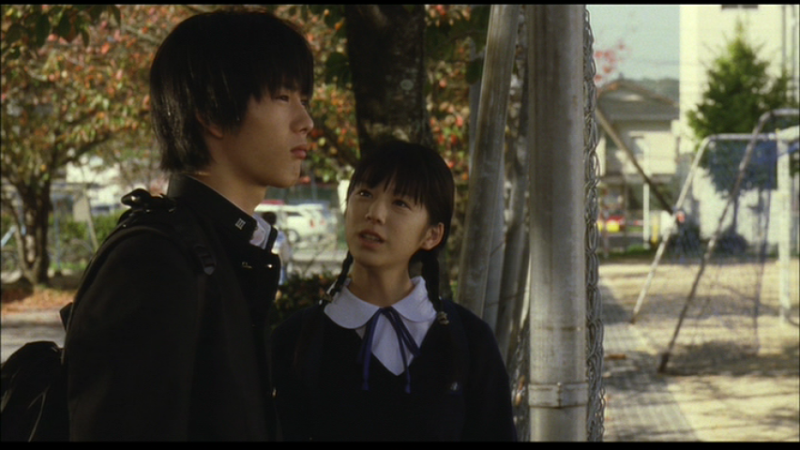 The films primary focus is on the oldest student in the school, Soyo (played by Kaho) now in ninth grade. While she has had friends in lower grades, she has never had a classmate in her own grade. At least, never until the start of the film -- when a newcomer from Tokyo (who has family ties to the village) arrives as a transfer student.
The films primary focus is on the oldest student in the school, Soyo (played by Kaho) now in ninth grade. While she has had friends in lower grades, she has never had a classmate in her own grade. At least, never until the start of the film -- when a newcomer from Tokyo (who has family ties to the village) arrives as a transfer student.
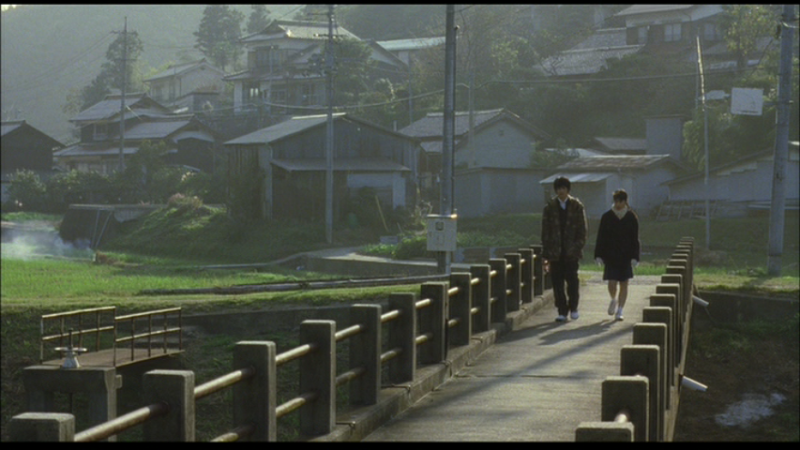 Most of the focus of this slow-moving and sweet-natured film is on the relationship that develops between Soyo and the newcomer Hiromi (Masaki Okada), though interactions with her family and schoolmates
Most of the focus of this slow-moving and sweet-natured film is on the relationship that develops between Soyo and the newcomer Hiromi (Masaki Okada), though interactions with her family and schoolmates 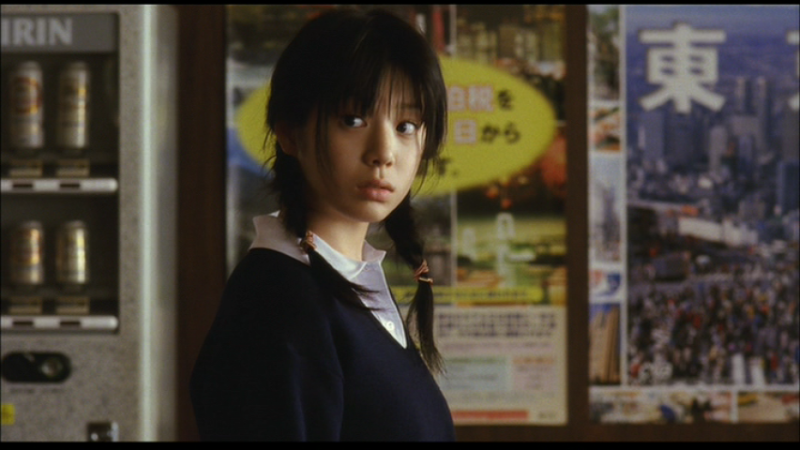 (most of whom are just "little kids") are not neglected. One complication of her friendship with Hiromi (other than his "attitude") is the fact that he turns out to be the son of her father's first love, who ran away to Tokyo long ago, but who has now returned.
(most of whom are just "little kids") are not neglected. One complication of her friendship with Hiromi (other than his "attitude") is the fact that he turns out to be the son of her father's first love, who ran away to Tokyo long ago, but who has now returned.
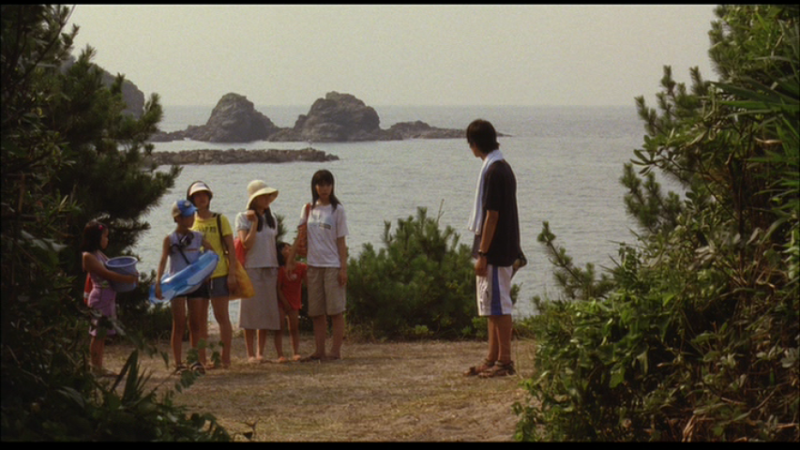 Not much of a plot here, but still -- things happen. Soyo trades her "first kiss" to Hiromi for his fashionable Tokyo windbreaker. The children go on excursions to the beach and to a local festival.
Not much of a plot here, but still -- things happen. Soyo trades her "first kiss" to Hiromi for his fashionable Tokyo windbreaker. The children go on excursions to the beach and to a local festival.  Soyo worries about whether her father might rekindle his old romance with Hiromi's mother. The middle schoolers go on a class trip to Tokyo. Just all the normal sort of things kids of this age do. In some ways, this bears a lot of similarity to what might be the first film of this sort, Mikio Naruse's 1947 Haru no mezame (Spring Awakens / Puberty).
Soyo worries about whether her father might rekindle his old romance with Hiromi's mother. The middle schoolers go on a class trip to Tokyo. Just all the normal sort of things kids of this age do. In some ways, this bears a lot of similarity to what might be the first film of this sort, Mikio Naruse's 1947 Haru no mezame (Spring Awakens / Puberty).
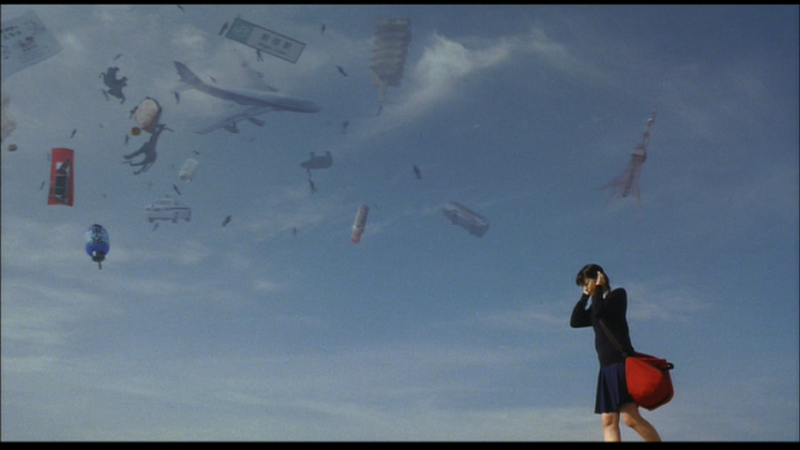 The performance by Kaho (who was the same age as the young heroine whose part she played) is very good. Her fellow star Okada, though a couple of years older than he ought to have been, likewise did a creditable job. The cinematography of Ryûto Kondô is quite lovely.
The performance by Kaho (who was the same age as the young heroine whose part she played) is very good. Her fellow star Okada, though a couple of years older than he ought to have been, likewise did a creditable job. The cinematography of Ryûto Kondô is quite lovely.  One's reaction to the film will probably depend on one's tolerance for a film that favors a low-key atmosphere and mood over plot. As for me, I enjoyed it a lot, albeit not as much as Yamashita's prior Linda Linda Linda, but to be fair that is probably my favorite film of the past couple of years.
One's reaction to the film will probably depend on one's tolerance for a film that favors a low-key atmosphere and mood over plot. As for me, I enjoyed it a lot, albeit not as much as Yamashita's prior Linda Linda Linda, but to be fair that is probably my favorite film of the past couple of years.
More screen shots:
http://i9.photobucket.com/albums/a59/mkerpan/linda/kokekko/tennen01.png
http://i9.photobucket.com/albums/a59/mkerpan/linda/kokekko/tennen06.png
http://i9.photobucket.com/albums/a59/mkerpan/linda/kokekko/tennen10.png
http://i9.photobucket.com/albums/a59/mkerpan/linda/kokekko/tennen12.png
http://i9.photobucket.com/albums/a59/mkerpan/linda/kokekko/tennen13.png
 The Japanese title of Yamashita's new films seems to translate to "natural cockle-doodle-doo". Although about the first thing one hears in the film is a rooster crowing (and we do see chickens from time to time), the significance of the title is not especially clear to me.
The Japanese title of Yamashita's new films seems to translate to "natural cockle-doodle-doo". Although about the first thing one hears in the film is a rooster crowing (and we do see chickens from time to time), the significance of the title is not especially clear to me.  The film (based on a popular shoujo manga) is set in Shimane Prefecture (the second least populous prefecture of Japan). Clearly built in the post-war baby boom era, the combined grade school and middle school now has less than 10 students -- and is probably reaching the end of its days.
The film (based on a popular shoujo manga) is set in Shimane Prefecture (the second least populous prefecture of Japan). Clearly built in the post-war baby boom era, the combined grade school and middle school now has less than 10 students -- and is probably reaching the end of its days.  The films primary focus is on the oldest student in the school, Soyo (played by Kaho) now in ninth grade. While she has had friends in lower grades, she has never had a classmate in her own grade. At least, never until the start of the film -- when a newcomer from Tokyo (who has family ties to the village) arrives as a transfer student.
The films primary focus is on the oldest student in the school, Soyo (played by Kaho) now in ninth grade. While she has had friends in lower grades, she has never had a classmate in her own grade. At least, never until the start of the film -- when a newcomer from Tokyo (who has family ties to the village) arrives as a transfer student. Most of the focus of this slow-moving and sweet-natured film is on the relationship that develops between Soyo and the newcomer Hiromi (Masaki Okada), though interactions with her family and schoolmates
Most of the focus of this slow-moving and sweet-natured film is on the relationship that develops between Soyo and the newcomer Hiromi (Masaki Okada), though interactions with her family and schoolmates  (most of whom are just "little kids") are not neglected. One complication of her friendship with Hiromi (other than his "attitude") is the fact that he turns out to be the son of her father's first love, who ran away to Tokyo long ago, but who has now returned.
(most of whom are just "little kids") are not neglected. One complication of her friendship with Hiromi (other than his "attitude") is the fact that he turns out to be the son of her father's first love, who ran away to Tokyo long ago, but who has now returned. Not much of a plot here, but still -- things happen. Soyo trades her "first kiss" to Hiromi for his fashionable Tokyo windbreaker. The children go on excursions to the beach and to a local festival.
Not much of a plot here, but still -- things happen. Soyo trades her "first kiss" to Hiromi for his fashionable Tokyo windbreaker. The children go on excursions to the beach and to a local festival.  Soyo worries about whether her father might rekindle his old romance with Hiromi's mother. The middle schoolers go on a class trip to Tokyo. Just all the normal sort of things kids of this age do. In some ways, this bears a lot of similarity to what might be the first film of this sort, Mikio Naruse's 1947 Haru no mezame (Spring Awakens / Puberty).
Soyo worries about whether her father might rekindle his old romance with Hiromi's mother. The middle schoolers go on a class trip to Tokyo. Just all the normal sort of things kids of this age do. In some ways, this bears a lot of similarity to what might be the first film of this sort, Mikio Naruse's 1947 Haru no mezame (Spring Awakens / Puberty). The performance by Kaho (who was the same age as the young heroine whose part she played) is very good. Her fellow star Okada, though a couple of years older than he ought to have been, likewise did a creditable job. The cinematography of Ryûto Kondô is quite lovely.
The performance by Kaho (who was the same age as the young heroine whose part she played) is very good. Her fellow star Okada, though a couple of years older than he ought to have been, likewise did a creditable job. The cinematography of Ryûto Kondô is quite lovely.  One's reaction to the film will probably depend on one's tolerance for a film that favors a low-key atmosphere and mood over plot. As for me, I enjoyed it a lot, albeit not as much as Yamashita's prior Linda Linda Linda, but to be fair that is probably my favorite film of the past couple of years.
One's reaction to the film will probably depend on one's tolerance for a film that favors a low-key atmosphere and mood over plot. As for me, I enjoyed it a lot, albeit not as much as Yamashita's prior Linda Linda Linda, but to be fair that is probably my favorite film of the past couple of years.More screen shots:
http://i9.photobucket.com/albums/a59/mkerpan/linda/kokekko/tennen01.png
http://i9.photobucket.com/albums/a59/mkerpan/linda/kokekko/tennen06.png
http://i9.photobucket.com/albums/a59/mkerpan/linda/kokekko/tennen10.png
http://i9.photobucket.com/albums/a59/mkerpan/linda/kokekko/tennen12.png
http://i9.photobucket.com/albums/a59/mkerpan/linda/kokekko/tennen13.png
Comments
I was talking with a friend about the reception of this film at the SFIAAFF as compared to that of Linda Linda Linda- many festgoers seemed moderately or even greatly disappointed, but though I may not want to buy and rewatch the DVD like I have with Yamashita's earlier film, I think a Gentle Breeze in the Village is just the kind of thing I like to see in a fleeting glimpse at a festival (especially since so much festival fare is so heavy).
On the subject of Japanese films at SFIAAFF, I saw the English-subtitled premiere of the 1936 Whispering Sidewalks and was surprised to see a credit for Sadao Yamanaka as cinematographer for the film. I had no idea he was a cinematographer as well as a director! The imdb lists a Masao Yamanaka in that role, but the imdb is notoriously faulty in its data sometimes, as you know. On the other hand it could be a subtitle error (I don't read Japanese). Any ideas on how to determine the answer to this?
I also, if you're inclined, would like to pick your brain on Teinosuke Kinugasa, who I'm embarking on a bit of research about.
It's sad to hear that Gentle Breeze got a poor reception in SF.
I was stunned by Naruse's Spring Awakens -- and find it hard to believe that this lovely little film has been ignored by retrospective programmers. On the other hand, given your report on the reception of Gentle Breeze....
JMDB does not list any cinematography credits for Yamanaka just ones for directing, script writing and original stories. JMDB is much more complete as to old Japanese films than IMDB -- but it also has plenty of gaps. Not certain what else one could check (nothing in English, I'm, sure).
I am not at all fond of the work of Kinugasa (who is my least favorite major Japanese director of the classic era -- so far). I've seen four of his films -- and I suspect that is probably sufficient for my purposes. Aaron Gerow has a book coming out soon on Page of Madness -- and he seems to have a higher opinion in general on Kinugasa than I do. ;~}
I think I may try to contact Linda Hoaglund, who is credited with the subtitle translation for Whispering Sidewalks, to get to the bottom of the Yamanaka issue.
I know you're no fan of Kinugasa, but you've seen more films than I have- for me it's just a Page of Madness so far, although I have just got a hold of a copy of Gate of Hell and I may cross the Bay Bridge to Berkeley to check out the sizable 50's & 60's Kinugasa holdings at the Pacific Film Archives. Though my project doesn't depend on seeing his films as much as on getting a handle on the context of their production and reception over the years as best I can.
I am pretty sure that Sadao Yamanaka did not work as a cameraman. He was pretty focused on writing scripts and directing.
You might find Kinugasa more congenial than I do. As long as you can see some of his work for free -- why not?